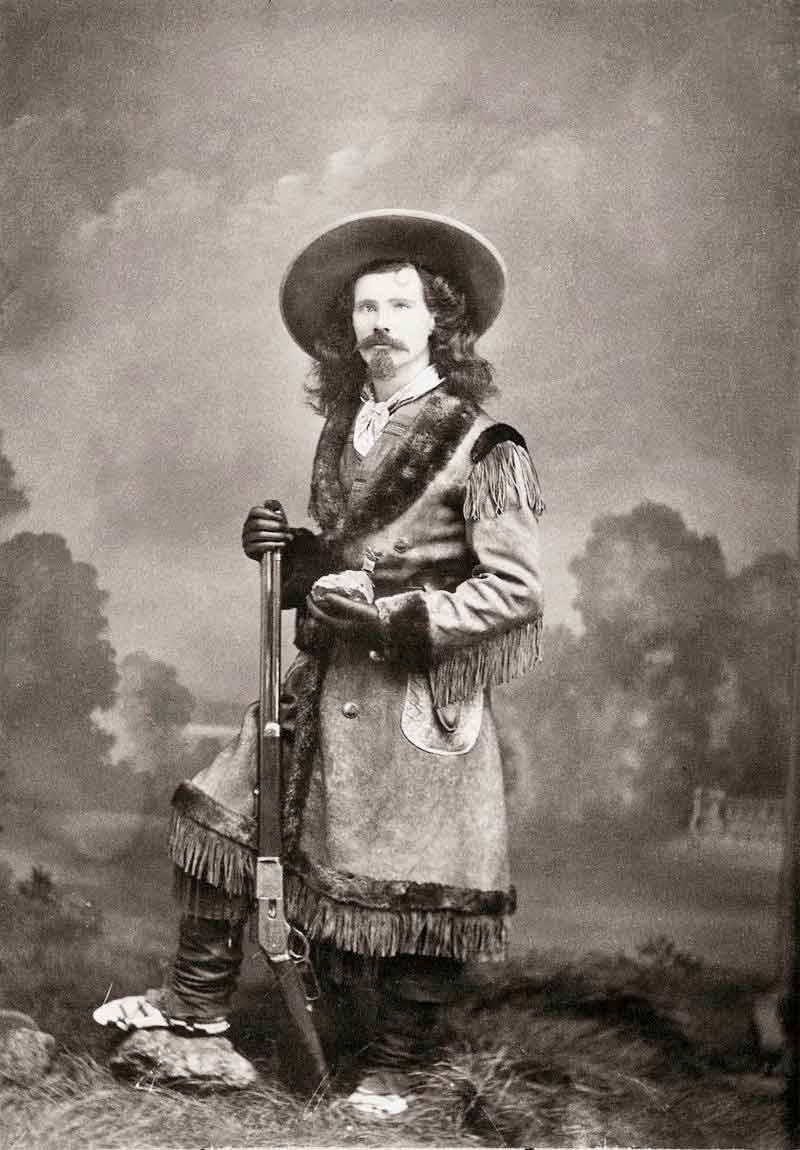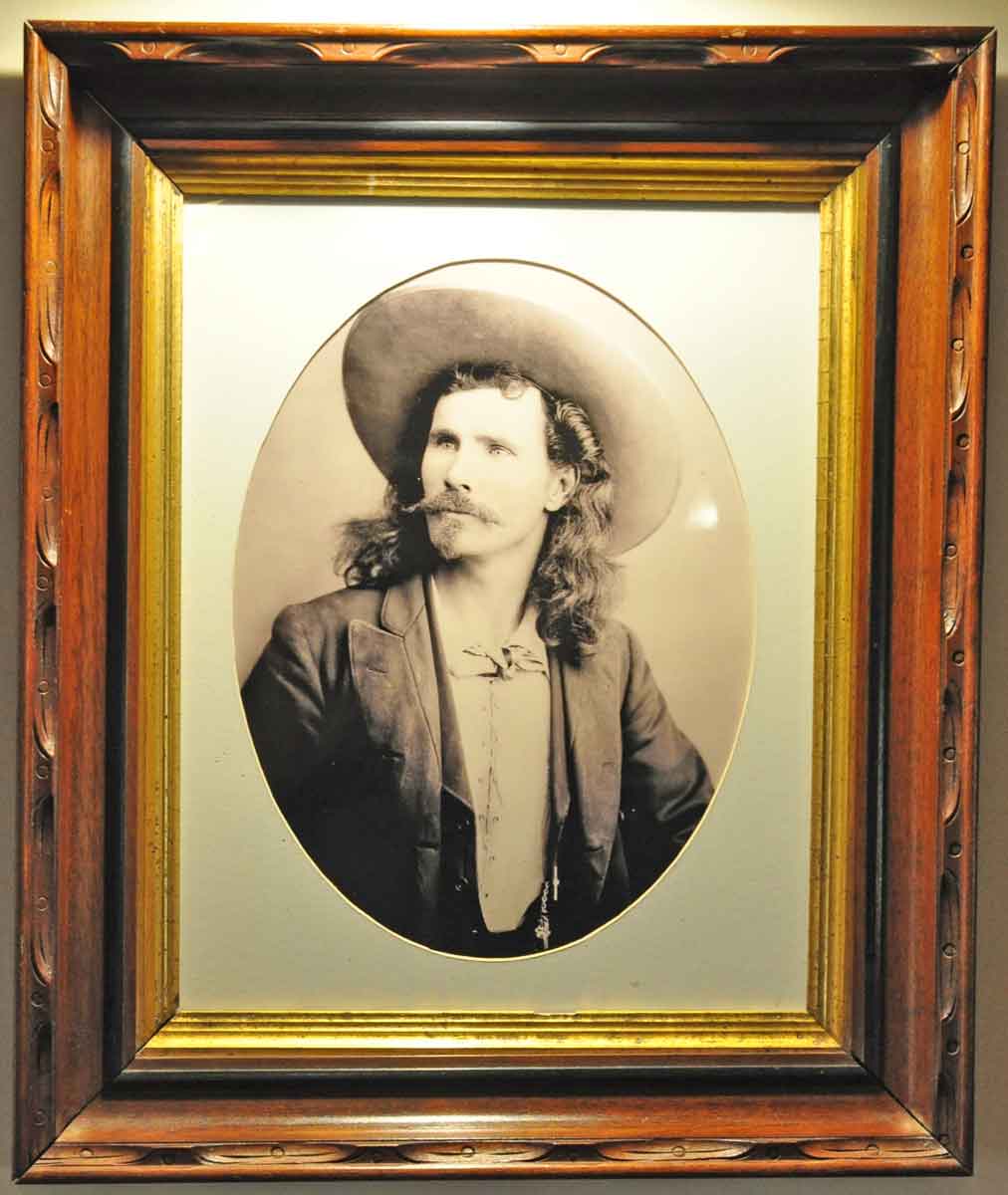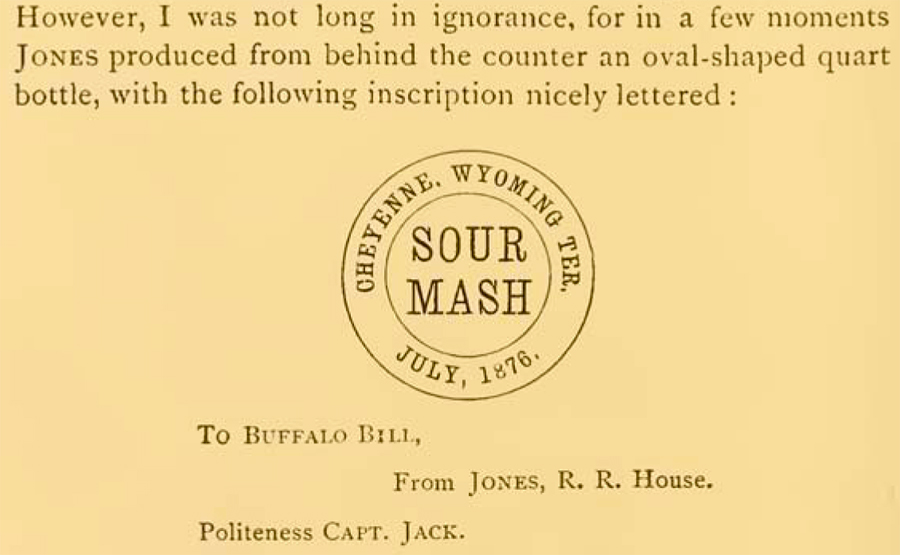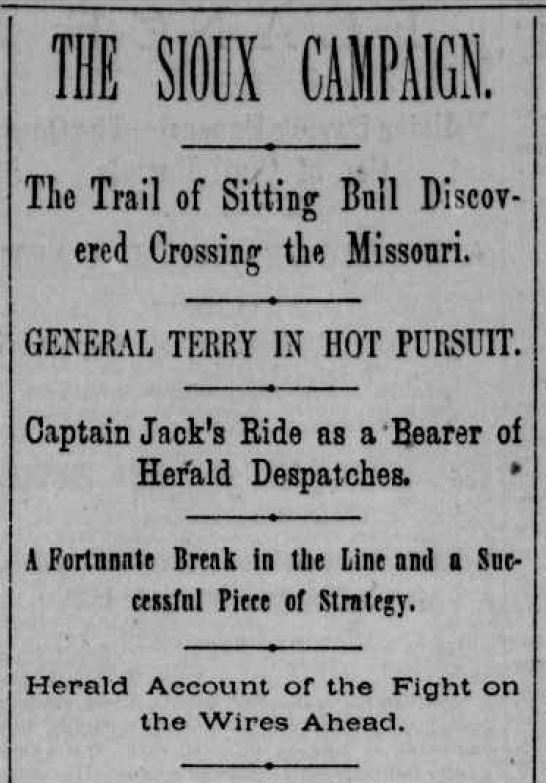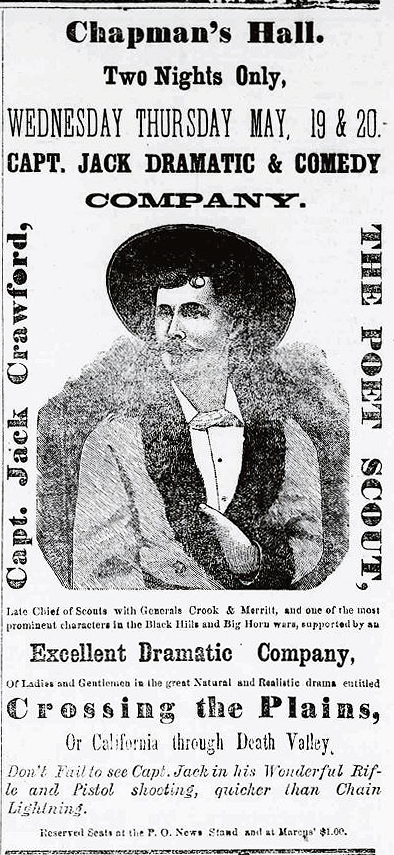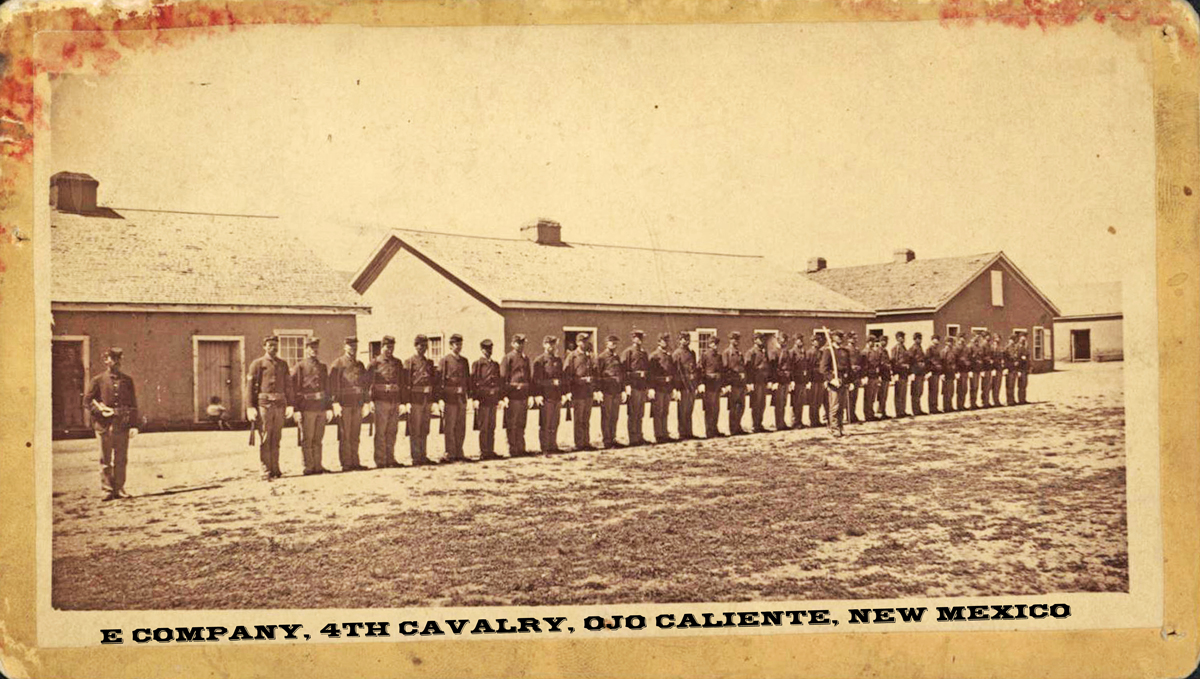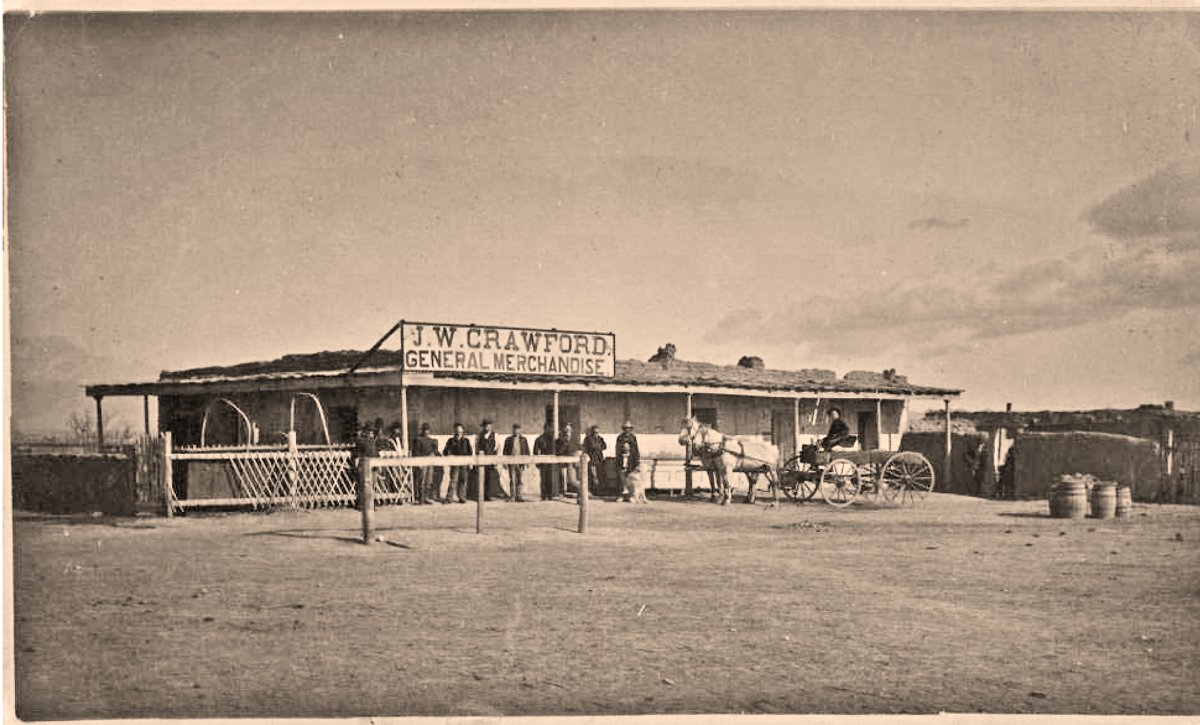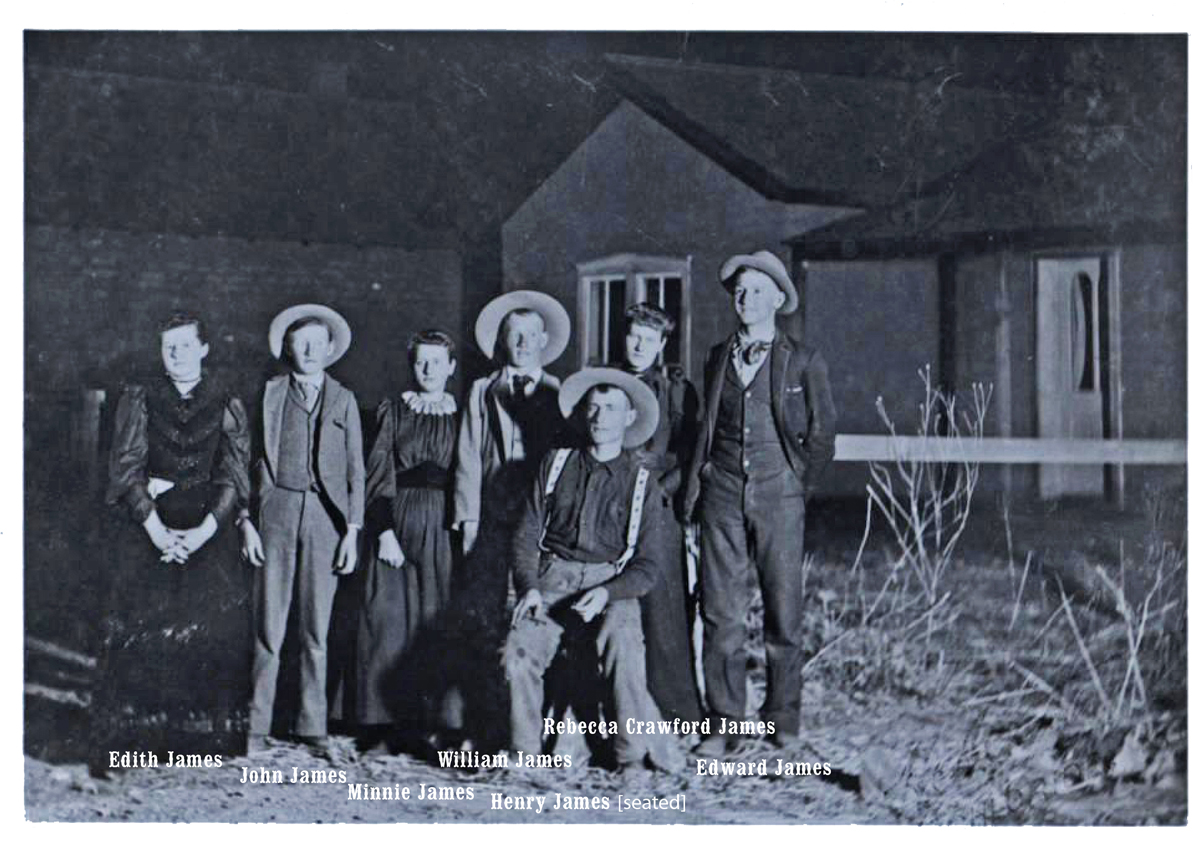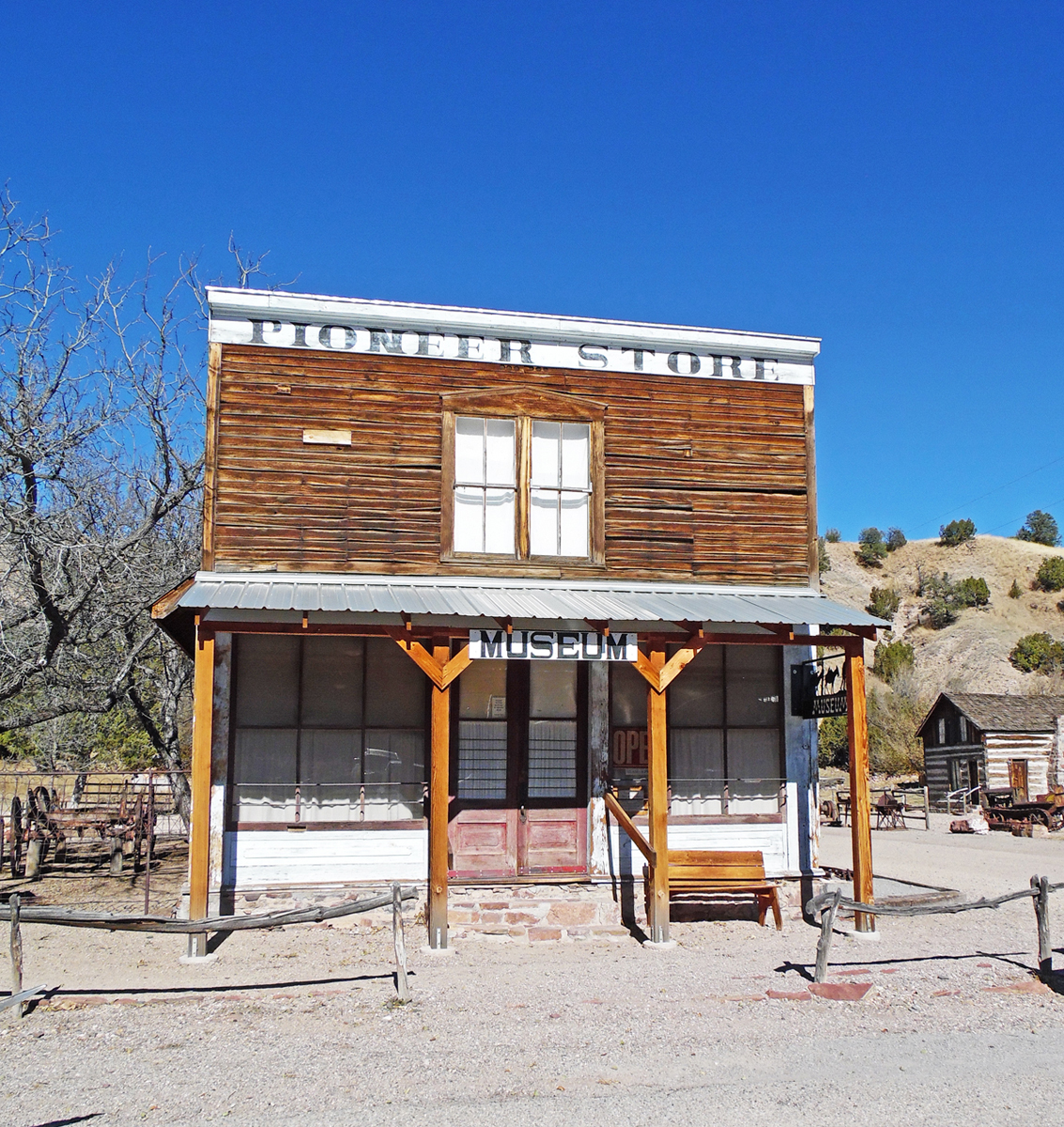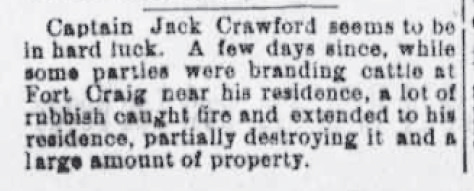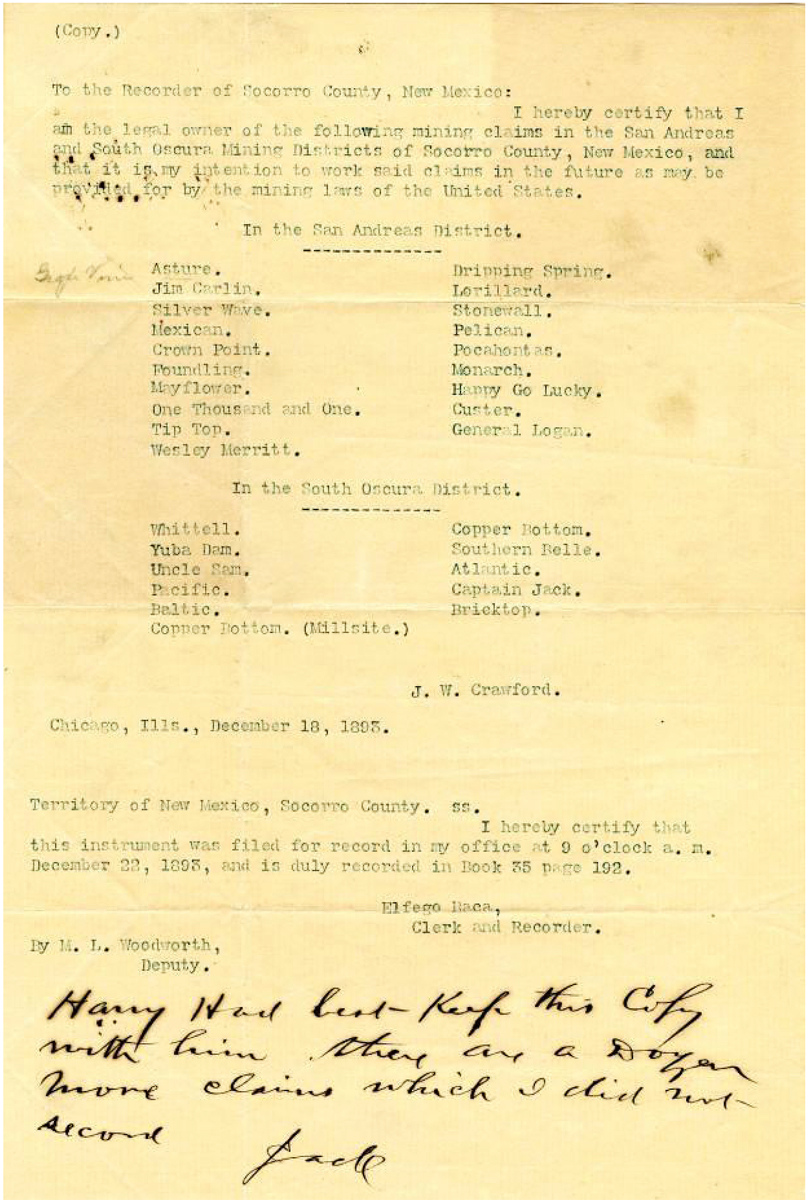Captain Jack Crawford, (1847-1914)
John Wallace Crawford
The Poet Scout
” If,” said he, ” I cannot make a reputation upon my own merits, I shall never endeavor to do so through false representations. I am simply Jack Crawford, boy soldier, rustic poet, scout, bad actor, etc.”
It was easy to get lost in the exploits of this man. So much of his writings an letters were preserved and there was so much written about him. while he lived. Captain Jack was a true western hero. Thus the fascination of this man’s thoughts, poetry, letters, and mainly deeds leads one, as one follows the thread, through numerous books, newspaper articles, personal letters, and even thoughts of competitors. It is a trip worth taking. Through his exploits, one can see our true west heritage unfold.
Captain Jack was an Indian Scout during the Sioux Indian and Apache Indian wars. He was also a civil war soldier, poet, song writer and singer, author, entertainer, prospector and miner, rancher and post trader at Fort Craig, New Mexico. In 1889 he was appointed a special agent in the Justice Department, for four years, investigating illegal liquor traffic on the Indian reservations in the western states and territories.
Opening the Black Hills
In 1876 the Omaha Daily Bee newspaper sent Captain Jack to report on conditions in the Black Hills. He journeyed into the goldfields and the Omaha Daily Bee published at least 30 of Captain Jack’s papers¹ that included descriptions of camp life, advice for pilgrims, descriptions of the area and of the Indian dangers. These articles were the beginning of Captain Jack’s fame as a local celebrity as well as allowing him to polish his humor, writing skills, and abilities as a scout.
Captain Jack Joins the Army Scouts; the Death of Custer
It is not documented where and when Captain Jack became friends with Buffalo Bill Cody, but apparently they were good friends by the time of General George Custer’s death at the Little Big Horn. Buffalo Bill sent Captain Jack a telegraph to Captain Jack in Chicago, where Captain Jack was meeting with General Sheridan regarding the Black Hills¹. The telegram asked if Captain Jack had heard of Custer’s death. Captain Jack wrote a poem in response, “The Death of Custer,” and sent it back to Buffalo Bill. Cody, sent another telegram to Captain Jack in Chicago asking Captain Jack to join him in helping to avenging Custer’s Death. General Sheridan appointed him as a scout while he was in Chicago. So Captain Jack was on his way to join the 5th Cavalry. This was one of two achievements that brought Captain Jack to the forefront of notoriety in the U.S.
Captain Jack Catches up to General Crook
The 5th Cavalry, under the command of General Crook was on the move to catch the Sioux. By the time Captain Jack had reached Cheyenne, Wyoming, the 5th Cavalry was on their way to Fort Fetterman, in Dakota Territory.
To catch the General, Captain Jack took a train to Medicine Bow, Wyoming (about 90 miles south of Fetterman). Riding on horseback, he left Medicine Bow, alone, to ride to Fort Fetterman. He reached the fort at about 2 in the morning (riding 90 miles in roughly 13 hours ²). But General Crook had already left Fetterman by the time Captain Jack arrived.
Captain Jack, and a military courier named Graves, left Fort Fetterman on August 2nd, 1876, riding at night and resting during the day to avoid the Indians. They caught up with General Crook at Rosebud Creek about 3 a.m. on the morning of August 8th. In his book The Poet Scout, Captain Jack wrote a description of this journey, braving a wildfire and hostile Indians, a journey between 300 and 400 miles in 5 days. It is a story certainly worth Reading.2
Besides the stamina, bravery, and what Buffalo Bill called “pluck and courage,”3 there was another “feat” during this journey which gives insight into the man known as the Poet Scout.
Temperance
Upon leaving Cheyenne, Mr. Jones, the proprietor of the Jones House in Cheyenne asked Captain Jack to do him a favor. He wanted Captain Jack to carry a small parcel to Buffalo Bill, to which Captain Jack agreed. Upon greeting and talking to Buffalo Bill, Captain Jack remembered he had a package for him.
Captain Jack said:” What would you most like to have at this moment?” Bill replied: “A good big horn of old Bourbon.” “Good enough ! You’ve struck it.” said Jack. Buffalo Bill responded: ” Git out — you can’t fool me. What ! you carry a bottle of Bourbon four hundred miles?” Jack Responded: “Well, you know, Bill, I don’t drink.” ” I know, and that’s why I don’t believe you would carry it so far.” said Bill. Captain Jack said “And I wouldn’t, but I promised a friend I would carry a parcel to you, and I’ve done it.” Captain Jack pulled out the bottle in an instant. Bill snatched it while he was about to hold it up to show its color against the sky. “What the mischief are you doing ? ” said Bill, concealing the bottle under his arm. ” Do you want the whole command to pounce upon it like a pack of wolves?” 2
Whom could one trust to carry a bottle of Sour Mash over 400 miles?…Captain Jack, of course! When Captain Jack’s mother was dying, she made him promise that he would not drink. He promised and kept his word, being quite proud of his ability to keep his temperance pledge and encourage others throughout his life to do the same.
Horsemeat March and Slim Buttes Battle
Captain Jack joined General Crook for one of the most grueling marches in U.S. military history, commonly known as the “horsemeat march.” General Crook, with his 2,200 men, soon began running short of food and supplies and ordered his men to go on half rations. “The General said there was no possibility of our starving, as we had plenty of horses and mules. He called his Field officers together, and gave orders to march to the Black Hills, telling them that we would have to live on horse and mule meat until rations could be procured”4. This march, spurred on by Crook’s knowledge that he had to produce results or be relieved by the President and by the public’s demand for vengeance of Custer (fevered by newspaper reporters across the nation), culminated in the battle of Slim Buttes, the modest but first victory of the U.S. against the Sioux.
General Crook has his victory and the food from the captured Indian village gave his forces temporary relief from starvation. However he still had two problems. He had to get the news of the battle back to his superiors before they read about it in the newspapers and he had to get food for his men.
The Dispatch Race
General Crook ordered Frank Grouard, a Scout, to carry dispatches to Fort Laramie with news of the battle and victory. Grouard was to ensure the official dispatches were telegraphed first, followed by the dispatches from the war correspondents. Grouard left in company with Captain Anson Mills, Lieut. Bubb and about seventy-five troopers riding ahead to the Black Hills mining camps to purchase provisions for Crook’s command. Captain Jack was told to ride with Mills’s party to secure provisions. Typical of reporters, Davenport wanted an exclusive for the New York Herald and offered Captain Jack five-hundred dollars if he could beat Grouard to the telegraph in Fort Laramie. Telegraphing news of the victory of Slim Buttes thus became a race between Frank Grouard and Captain Jack Crawford.
The Race is On!
When Grouard reached Deadwood, he saw the mule that Captain Jack had been riding. It was then that Grouard learned that Captain Jack was trying to get to the telegraph wires ahead of him. Captain Jack rode to Deadwood, while Grouard slept. Apparently this made the rivalry between Grouard and Captain Jack even more intense, as evidenced by Grouard’s comments about Captain Jack in his book, The Life and Adventures of Frank Grouard, Chief of Scouts, U.S.A.4 Regardless, Grouard knew he had to get to the telegraph first because his orders were to get the General Crook’s official dispatches on the wire before the war correspondent’s dispatches. Having the means to purchase horses, Grouard caught up with Captain Jack outside of Custer City.
Captain Jack Discharged from Scouts, But The race Continues…
Grouard, quite angry with Captain Jack, informed him he was discharged from the Scouts as soon as he left Mills command. Captain Jack stated that he had permission from Colonel Merritt to leave Mills’ provisions party and take up Davenport’s offer. (Apparently, this is what Captain Jack believed because, later, he wrote a letter to General Crook trying to clarify the matter 5.) In his anger, Grouard gave Captain Jack a copy of Davenport’s dispatches, thus providing Captain Jack with two copies. Captain Jack and Grouard agreed to rest in Custer City, but unknown to Captain Jack, Grouard had hired a man to carry the dispatches to Camp Collier at Red Canyon, South Dakoda. From there, military couriers would carry the dispatches to Fort Laramie.
Upon reaching Custer City, Grouard was so exhausted that he had to be lifted from his horse. After confirming that his dispatches were on their way, he was bed ridden for three days.
Meanwhile, Captain Jack left Custer City at 9 a.m. the following morning and was at Red Canyon at 3 p.m. There the Commanding Officer, a friend of Captain Jack, convinced him to spend the night as the other couriers were 24 hours ahead of him, thus he had little chance of catching them.
An Idea Pays Off
Captain Jack spent the night, but he got a great idea and left the next morning heading for Hat Creek Station on Sage Creek, in Wyoming. There, the telegraph lines were down, but he left a copy of Davenport’s dispatches with instructions to get them on the wire as soon as the lines were repaired. Meanwhile, Captain Jack continued the ride to Fort Laramie. When Captain Jack reached a place called Government Farm, along the way to Fort Laramie, Crawford learned that his dispatches “were on the wire, and ahead of all others.” (Government Farm is 48 miles from Sage Creek, which he rode in 5 hours.) Captain Jack continued to Fort Laramie with the additional copy of the news dispatch being sent back East, while the military couriers were racing to Fort Laramie to use the telegraph there. Rural telegraph systems, had only one set of wires and when someone started sending a message, the other operators had to wait until a message was sent to get their turn on the wire.
Captain Jack Crawford rode on into Fort Laramie on September 16, just hours after the military courier. In his words “I rode 325 miles in six days and am pretty well exhausted.”6
Some Months later, James Gordon Bennett of the Herald paid Crawford the $500 that Davenport had promised and an additional $222 to cover expenses.
Twelve Hundred Miles in 50 Days
Just think about what Captain Jack endured and accomplished from the time he left Medicine Bow, on July 28th. He reached Crooks forces on August 8th. He rode with Crook’s forces, during the grueling horsemeat march on starvation rations. They overcame the Indians, and fought in the battle of Slim Buttes. On the 11th of September, he began the race to Ft. Laramie to deliver his dispatches and arrived on September 16. In just 50 days, Captain Jack traveled nearly 1,200 miles on horseback across rugged terrain, in hostile Indian country, including coping with severe weather.
Theatrical Tours
On November 25, 1876 Captain Jack Crawford left Omaha, Nebraska to Join the Buffalo Bill Combination. (A Combination is a theatrical touring company which performed only one play.) He was 29 years old. It was during the period from 1876 to 1880 he developed his taste and talent for the theater and public life.
Already a singer, songwriter, and poet, Captain Jack was always welcomed around the campfire by miners, cowboys and solders. Now he would thrill audiences across the country. Eventually leaving Cody’s show and starting out on his own, he would do great as a performer; but not-so-good as a businessman.
He tried his hand at mining as well as continuing to write his poetry and publish books and a play. In 1880 Captain Jack came to New Mexico with his theatrical troupe. Although his troupe received good reviews, Captain Jack and the Captain Jack Combination were soon broke. But fate offered Captain Jack a way out of his predicament.
General Buell’s Chief of Scouts
Captain Jack offered his services as scout to Colonel Edward Hatch to help fight the Apaches who were on the war path in New Mexico. Accepting the position of chief of scouts for Gen. Buell, he promised General Hatch that he would remain in the field until Victorio was killed or the campaign ended.
Ojo Caliente and the Victorio War
Just 25 miles south from Concho Hills Guest Ranch, lies the Ojo Caliente and what is now called the Monticello Box.
The Tchine (Chi-en-day) Apache, or Red Paint People, (also known as the Mimbres, Eastern Chiricahua, or Warm Springs Apaches) claimed the Ojo Caliente as their homeland. Political pressure to move the Warm Springs Apache off their reservation resulted in the Victorio War of 1879 and 1880.7 It was during this period 1879-1881 that Ojo Caliente came into its own as a base for military operations and a military post. 8 The melting walls of the old adobe fort structures still exist at Ojo Caliente.
Saved by his Hero (Dog)
Captain Jack’s story almost ended in July, 1880. As reported by Captain S.C. Plummer of the regular army, a few soldiers from Fort Craig accompanied by Captain Jack decided to go bathing in the Rio Grande. While having fun in the water, someone discovered that Captain Jack was rather ticklish. While trying to escape his tormentors, Captain Jack wandered into deeper water and apparently some quicksand. After being submerged “longer than a man would willingly stay,” the men heard what sounded like “a roar of a lion” as Captain Jack’s albino St. Bernard headed for his master. After getting free of the quicksand, Captain Jack was caught in the swift current of the river and, being nearly exhausted, could not make headway against the current. The dog (appropriately named Hero), grabbed Captain Jack by the hair and brought him safe to shore, nearly a mile from where he first went down. The event was published in newspapers across the U.S. A full account as well as well as a poem written for the dog can be read in Captain Jacks Book, A book of Song and Story. 9
Scouting in New Mexico
By mid-1880, Captain Jack was sent from Fort Craig on scouting expeditions, looking for signs of Indians. He kept a diary of these trips and it is fascinating to read.10 It is amazing how much territory Captain Jack covered and mostly alone. These trips also allowed him to survey mining prospects in the Black Range and Mogollon Mountains, to the south and west of Fort Craig, and in the Oscura and San Andres mountains, east of Fort Craig. With his experience in mining (he came from a mining family) and with opening the Dakota Territory he believed there was great mineral wealth in New Mexico. So much so that apparently he began under takings to lead the mining in those areas.
On August 12, 1880, on one of these scouting trips, he encountered Billy the Kid which he later wrote about in an essay “How I met Billy the Kid.”11
Later, in August or September, he reported to Fort Cummings and Colonel George P. Buell.
In September, Colonel Buell was organizing a large expedition to find Victorio. He ordered Captain Jack to cross into Chihuahua, Mexico, to locate Victorio’s camp. With two interpreters, one Spanish and one Indian, Captain Jack spent the next several weeks trying to pick up Victorio’s trail. Captain Jack located the Apache camp, but the Indian interpreter was afraid to enter the camp. Without an interpreter, the only thing Captain Jack could do was ride to El Paso, Texas, where he wired Buell of Victorio’s location. Captain Jack met Buell at Palomas, Mexico, from where they continued the pursuit of Victorio. Buell made Captain Jack his Chief of Scouts.
In October, Mexican troops killed Victorio at Tres Castillos. With the Victorio campaign over, Captain Jack resigned as a government scout. Col. Buell wrote Crawford a letter of commendation:
“There is no doubt but what your scout after Victorio into old Mexico, and the rapidity with which you located him in the Candelaria Mountains, and your fast ride to the nearest post, from whence you wired me at Fort Cummings, was the cause which led directly to his death by the Mexican troops; for through your energy, pluck and perseverance, our forces harassed and drove him until he was almost dismounted and without ammunition… “12
Mining
Not wasting any time, Captain Jack immediately proceeded with his mining interests …perhaps too fast. On November 13, 1880, the Las Vegas Gazette wrote:
“Returning from a campaign against Victorio, in which he rode over 2,600 miles in Old and New Mexico, being for days at a time in the saddle, he found urgent letters demanding his presence in Denver on business connected with the Placer Prospecting Mining and Milling Co. …During his scouting expedition, Jack, although he has before stumbled upon untold millions, found prospects that fairly dazzled him. He has located many claims and a party of experienced miners have been awaiting his arrival in Denver for several weeks, all equipped for a thorough development of this comparatively unknown region. …A vast amount of territory will be explored and as soon as good locations are made, the company, under whose instructions he is acting will furnish the necessary machinery for developing the mines. Assays will be made on the spot so that no time will be lost, and in short, no company so thoroughly organized has ever set to work in this or any other country.”13
Some time prior to September 1880, Captain Jack became the “Chief Scout and Prospector” for the Lode and Placer Prospecting and Mining Association, headquartered in Denver. Having left Buell in October and being in Denver in November outfitting a party of prospectors shows the haste in Captain Jack’s thinking to get started. Upon returning to New Mexico with his party, Crawford established a base camp near the military outpost at Ojo Caliente, about thirty-five miles west of Fort Craig. 14
As early as December 1880, there was correspondence between Captain Jack and the company alluding to problems within the Lode and Placer Prospecting and Mining Association. 15
Although Victorio’s war was over, other Apache bands continued to threaten New Mexico. In January 1881, Captain Jack’s mining party was surprised by a party of Apaches. Captain Jack was wounded in the hand and was almost killed. Bullets had pierced his coat at the shoulder and another had passed through the skirt of the coat.16
Captain Jack’s mining party continued prospecting and locating claims. After spending two months prospecting, Captain Jack’s party had exhausted its supplies, and company officials failed to send additional money. Captain Jack was using his own money to keep the venture going. The money from Denver never came. But who can tell the story better than Captain Jack? The following is an excerpt from The Las Vegas Daily Optic:
“March 16, 1881
Ratifying a Rumor
The Lode and Placer Association Turns out to be Wild-Cat.
Captain Jack Crawford Makes a Statement and Tells All.
On February 26th The Optic published an article to the effect that rumors were on the air touching the integrity of the Lode and Placer Prospecting and Mining Association of Denver. Our authority came from a direct source and we believed at the tie that the association with the long name was a fraudulent concern, and that its operations in New Mexico were not exactly on the square. …
…Ojo Caliente, March 10
Editor Optic – I [Captain Jack] am in receipt of the Optic of the 28th ultimo, and in reply would respectfully say that you were correct in denouncing the Lode and Placer as a swindling outfit. The game is all up. The secretary kept writing and telegraphing that he would be here with money to pay the men and settle all bills, but never showed up. Finally on February 26th, he sent a telegram that Lode and Placers was busted! I cannot write what I feel. Never did man start out with more determination to win than I. How hard I worked everybody who has had dealings with me can attest. I was actually compelled to sell my effects and buy grub for my men to keep the wolf from the door. I borrowed money and ran into debt, a thing I always hated to do. I tell ya, Friend, I have heard of men being killed for less offense than this. Do you suppose that “Billy the Kid” who is waiting to be hung, perhaps, is any more guilty of robbery than the Denver men who took $100 each of my men on false pretenses, and then refused to furnish them with arms when the Indians had surrounded them? Had one of these men been killed I should not have been satisfied with calling the Lode and Placer people thieves, but murderers as well.” 17
The lack of success was more because of his trust in other men, rather than the lack of initiative and aptitude.
Moves to New Mexico
Captain Jack was convinced that New Mexico had the potential he needed to be successful and he wanted to make it his home. From Chloride, New Mexico (about 50 miles from Concho Hills) he wrote an article published in The Military Review, on May 1st,.1881. In that article he mentioned how times have changed in just three months from when the Indians attacked him and his men. (This implies that the January attack occurred in Chloride.)
“Houses are going up one after another in rapid succession. Doctors, lawyers, and other ‘tender-feet’ are coming in by the dozens, and each stage brings its load of prospectors, miners or capitalist;” 18
Fort Craig Post Trader
Captain Jack sought other means to support his mining ambitions. In mid- May he was awarded government contracts to supply the military post at Ojo Caliente with forage and fuel. A board of officers at Fort Craig recommended his appointment as post trader. 19 After his appointment as Post Trader, he sent for his wife, Maria, and his two children, Eva and Harry, to join him.
Captain Jack’s belief that New Mexico had much potential was clearly demonstrated by moving this immediate family to New Mexico (they hadn’t been together for years). Not only that, but he also told his brother-in-law, William James, and his brother Austin about New Mexico’s potential and recommended that they move to New Mexico, which they did in 1882. Several deeds were recorded in Pennsylvania transferring property from both Captain Jack and Austin to William H. James, perhaps for sale by William.20
William James and Family
William “Billy” H. James, was an Irish immigrant who reached the United States in 1862 and settled in Minersville, Penn. Six years later, he married Rebecca Crawford, Captain Jack’s sister. The Crawfords also hailed from Ireland, and young men of the family were employed in the mines. Captain Jack met Billy James on the job and may have introduced Billy to his sister.
By 1881, Billy was looking for an opportunity to advance his family’s well being. From Fort Craig, Captain Jack wrote Billy James in Minersville, suggesting he come out to Chloride. Bidding farewell to his wife and children, he headed for New Mexico. Billy James obtained work right away at the nearby Silver Monument Mine, and prospered. A year after his arrival, he brought out his family and put them up in a spacious house he had bought.
Jack Crawford’s daughters, Eve and May, and his son, Harry, often came from Fort Craig to visit their cousins. Those were boisterous occasions.
Unfortunately, Billy would be killed in a mining accident in 1887. He was survived by Rebecca and his six children.21 Rebecca remained in Chloride until at least 1903. She passed away in 1916 during an operation at Elephant Butte. The James family became a prominent family in Chloride and even owned the Pioneer Store which is now a museum in the town.
Austin Crawford
Austin Crawford (Captain Jack’s brother) moved to Chloride sometime before 1882 and ran a livery stable at that time in addition to other businesses: such as mining assessment, mining, and ranching. He married Amanda Hass of Chloride in December 1887. Being a mason, he built several buildings in Chloride; a few of which are still standing today.
Later, in 1883, Austin Crawford’s brother-in-law, William Nattress joined the family in New Mexico, temporarily working for Captain Jack. He also liked the potential he saw in New Mexico, especially Chloride. Austin Crawford purchased the Chloride blacksmith shop, corral and stable for William in 1884.22 William also moved his family to Chloride.
Black Range Newspaper Speaks of Captain Jack
One of the best newspaper articles I have found that gives insight into Captain Jack, was a full page article written in the Black Range newspaper (printed above the Pioneer Store in Chloride) on January 16, 1885. It began with a lead-in article previously published in the Washington (D.C.) Post, on November 30th, 1884, written by E.L. Keys, a friend of Captain Jack. The lead-in article was expounded upon the editor of the Black Range. At the end of the article the editor of the Range wrote:
“The tradership of Fort Craig has been a good paying Institution and Jack should be in much better financial condition than he is, although he is by no means a pauper, but his generosity will always keep him short of ready cash. No ragged miner or worn tramp ever called upon Jack In vain and legions of unprincipled scalawags have taken advantage of his softness of heart to dupe him of his, money. Though he has an interest in livery stables In Chloride and San Marcial and has valuable ranch and mining property, yet if he ever gains riches they will have to come in a bunch. His mines are in the Sun Andres both his galena and his copper properties-are highly spoken of as to probable value by those who have examined them, and it is possible that these are to be the sources of the competence which will protect his feet on the downhill path of life. The Range hopes they may.” 23
Captain Jack engaged in several businesses, to try and pay for his mining ventures and properties. While serving as post trader, he also filled government contracts, developed mines, established a dairy ranch, and expanded his land holdings. Later he would build a horse ranch in the foothills of the San Andres Mountains.
Military Abandons Fort Craig
With the Indians placed on reservations and the attacks on settlers under control, the military abandoned Fort Craig in 1884. Captain Jack and his family stayed on as caretakers of the facility. But obviously his income from the tradership would suffer.
Fire at Fort Craig Trading Post
In addition to the hardships of founding and attempting to manage several enterprises, he was also had the normal day to day hard luck that many settlers faced. In 1886, a cattle branding fire occurred at Fort Craig that destroyed most of his residence. 24
Finds Buried Confederate Cannons in Albuquerque
In 1889, Major Trevanion T. Teel, then a resident of El Paso, Texas, was in Albuquerque and told an interesting story to Captain Jack Crawford. On April 20th, 1862, when the Confederates were ready to evacuate Albuquerque, they buried eight cannon under the direction of Major Teel. Twenty-seven years later, Major Teel and Captain Jack formed a “digging committee” and found the cannon, northeast of the Albuquerque plaza, about 500 yards from the San Felipe Church. 25
Captain Jack Appointed Special Agent
In 1889 Captain Jack was appointed a special agent in the Justice Department, investigating illegal liquor traffic on the Indian reservations in the western states and territories. A position that again required a lot of travel.
Captain Jack Files Mining Claims With Elfego Baca
In 1893 Captain Jack had to file his mining claims with the Socorro County Clerk. The clerk at the time was another famous (some say infamous) New Mexico true west icon, Elfego Baca. Elfego Baca was a a gunman, lawman, lawyer, and politician in New Mexico whom Walt Disney based a television series about in 1958. But his is another story in New Mexico’s true west history that I will have to research and share with you.
Captain Jack Leaves New Mexico
In 1898, Captain Jack left New Mexico went to the Klondike to seek his fortune. Still never “striking it rich,” he returned to lecturing, performing, and entertaining (something he never really gave up). He gave performances at the Garcia Opera house in Socorro, New Mexico.26 He performed across the country, sometimes to a crowd of over a thousand people. He never missed an opportunity to help New Mexico and was an ardent booster the Territory.27
Summary
I believe Darlis A. Miller characterized Captain Jack best when she said:
“Crawford, the entertainer, however, was a man of action who had participated in the closing of the American frontier. He captured the imagination of eastern audiences because he embodied qualities they come to expect of a western hero. Honest, brave, rugged, and self-reliant, Crawford had fought Indians, captured lawbreakers, prospected for gold, and wrangled horses during a supposedly simpler age that easterners came to regard with longing and nostalgia. On the stage, Crawford used his western experiences, including his stint as post trader at Fort Craig, to educate audiences about their frontier heritage. Above all else, then, Crawford should be remembered as one of the important image -makers of his day, for he helped thousands of middle-class Americans formulate their ideas about the American West.”14
When I visit or take guests to places such as Chloride, Ojo Caliente, or the Garcia Opera House, I am in awe that I live in such a place where these people and heroes of the old west actually lived. I hope this overview of Captain Jack Crawford will stimulate some to read more about this incredible individual.
Sources and Acknowledgements
Personally, I believe that “the water is always clearer closest to the source,” meaning that the closer one gets to the source of information, personally and in time, the more truthful insight one will obtain. If one really wants to understand and appreciate Captain Jack, then one should read his books of stories, poetry, and song. Many of these are available as e-books free to those who wish to read them. We are so fortunate that Harriet Crawford Richardson had the foresight to gift personal family and personal papers, research, and drafts of writing projects as well as correspondence related to business and personal matters of Captain Jack to the McCracken Research Library. The McCracken Research Library and the Buffalo Bill Center of the West are private organizations dedicated to educating people and sharing (not hoarding) our western heritage. I also encourage one to read Darlis A. Miller’s extensively researched book: Captain Jack Crawford; Buckskin Poet, Scout and Showman.
Note:
The Two studio photographs of Captain Jack Crawford were taken by J.E. Smith, and are part of the copyrighted J.E. Smith Collection. J.E. Smith was a photographer in Socorro and area until 1889. Prints of over 1000 photographs are available from Leon Miler at the Alamo Gallery and Gifts in Socorro. (575) 835- 2787 or (575) 418-8901.
References:
1Captain Jack Crawford Buckskin Poet, Scout, and Showman, Darlis A. Miller, University of New Mexico Press, Albuquerque, NM, 1993
2 The Poet Scout: Being a Selection of Incidental and Illustrative Verses and Songs, Captain Jack Crawford, H. Keller &Co., San Francisco, CA, 1879
3 An Autobiography of Buffalo Bill (Colonel W.F. Cody), Cosmopolitan Book Corporation, N.Y; 1920
4 The Life and Adventures of Frank Grouard, Chief of Scouts, U.S.A; Joe De Barthe; Combe Printing Company; 1894
5 Correspondence: Jack Crawford to General George Crook, September 4, 1876, McCracken Research Library, John Wallace Crawford Collection, MS322.03.06.01
6 New York Herald, New York, September 18, 1876
7 Canada Alamosa Project Website; Karl W. Laumbach; http://www.canadaalamosaproject.org/04-research-design-kwl
8 Fort Craig, United States Fort o the Camino Real, Collected Papers of the First Fort Craig Conference, U.S. Departmant of the Interior, Bureau of Land Management, 2000; Chapter 11, Ojo Caliente; Stephen H. Lekson
9 The Poet Scout, A book of Song and Story; Captain Jack Crawford, Burr Printing House, 1889.
10 Note from Diary 1880, McCracken Research Library, John Wallace Crawford Collection, MS322.16.27.01
11 How I Met Billy The Kid, Autobiography, Captain Jack Crawford, McCracken Research Library, John Wallace Crawford Collection, MS322.14.28.01
12 Clipping of Letter from General George P. Buel and Endorsement of Poet Scout, McCracken Research Library, John Wallace Crawford Collection, MS322
13 Las Vegas Daily Gazette, Las Vegas New Mexico; November 13, 1880
14 Territory of New Mexico. Report of the Secretary of the Territory 1903-1904 and Legislative Manual, 1905
15 Correspondence between Captain Jack Crawford and Conners of Lode and Placer Prospecting and Mining Association, McCracken Research Library, John Wallace Crawford Collection, MS322.05.05.01
16 Daily New Mexican, Santa Fe, Feb 4, 1881
17 Las Vegas Daily Optic, Las Vegas, New Mexico; March 16, 1881
18 The Military Review, Santa Fe, New Mexico, May 1, 1881
19 Fort Craig, United States Fort o the Camino Real, Collected Papers of the First Fort Craig Conference, U.S. Departmant of the Interior, Bureau of Land Management, 2000; Chapter 13, Captain Jack Crawford, Poet Scout and Post Trader, Darlis A. Miller
20 The Columbian, Bloomsburg, PA, Friday, May 5, 1882
21 The Black Range, Chloride, New Mexico; December 9, 1887
22 The Black Range, Chloride, New Mexico; January 25, 1884
23 The Black Range, Chloride, Sierra County, New Mexico; January 16, 1885
24 Las Vegas Gazette, Las Vegas, New Mexico; June 2, 1886
25 Turmoil In New Mexico, 1846-1868: Facsimile of 1952 Edition By William A. Keleher
26 The Socorro Chieftain, Socorro, New Mexico; June 1, 1901
27 Santa Fe New Mexican, Santa Fe, New Mexico; January 23,1908

